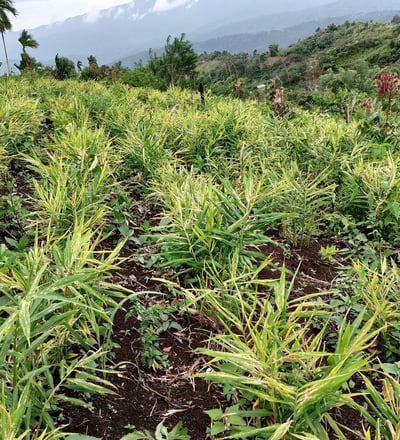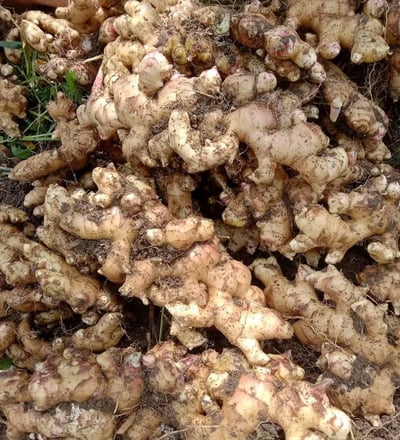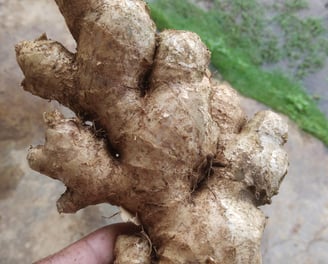Ginger
Benefits
Ginger is a highly versatile spice renowned for its distinctive, spicy flavor and wide range of health benefits. It is rich in bioactive compounds like gingerol, which have potent anti-inflammatory and antioxidant effects. Ginger is commonly used to alleviate nausea, particularly morning sickness during pregnancy, and is effective in treating motion sickness and indigestion. It also has anti-inflammatory properties that can help reduce muscle pain and soreness, making it popular among athletes. Ginger is known to lower blood sugar levels, improve heart health by reducing cholesterol, and has been shown to have anti-cancer properties in some studies. Additionally, it is used in traditional medicine to treat colds, flu, and respiratory issues, and is often consumed as a tea or in warm drinks to promote overall wellness.
History in Indonesia
Ginger has a long history in Indonesia, where it has been cultivated for centuries and is an integral part of the local cuisine and traditional medicine. The spice was introduced to Indonesia through trade routes from India and China, and it quickly became a staple in Indonesian households. During the spice trade era, ginger was one of the many spices that attracted traders from across the world, including Arabs, Indians, and Europeans. The Dutch East India Company (VOC) capitalized on the spice trade, exporting large quantities of ginger from Indonesia to Europe and beyond. Today, Indonesia remains one of the world's largest producers of ginger, with the spice continuing to play a vital role in the country's agricultural economy and culinary traditions.
Cultivation and Growth
Ginger thrives in tropical and subtropical climates, making Indonesia's warm and humid environment ideal for its cultivation. It is typically grown in regions like Java, Sumatra, and Bali. Ginger plants require well-drained, fertile soil and ample rainfall. The rhizomes (underground stems) are the edible part of the plant, and they are typically planted in raised beds to prevent waterlogging. Ginger plants grow best in partial shade and prefer temperatures between 25°C to 30°C (77°F to 86°F). The plants reach maturity within 8 to 10 months, at which point the rhizomes are harvested.
Harvesting Season
Ginger can be harvested at different stages of maturity, depending on its intended use. Early harvests, around 5 to 6 months after planting, yield young ginger, which is milder and less fibrous, often used in fresh dishes and pickling. Mature ginger, harvested after 8 to 10 months, has a stronger flavor and is more commonly used in cooking, dried, or processed into ginger powder. The harvesting season in Indonesia typically falls between May and November, depending on the region and climate conditions. After harvesting, the ginger rhizomes are cleaned, sun-dried, or processed for various uses.
Shelf Life
Fresh ginger has a relatively short shelf life and should be used within 2 to 4 weeks when stored in a cool, dry place or refrigerated. Dried ginger, on the other hand, can last for up to 1 to 2 years if stored properly in an airtight container away from moisture and light. Ground ginger has a shorter shelf life of about 6 months to a year, as it loses its flavor and potency more quickly when exposed to air. To preserve its quality, ginger should be stored in a well-sealed container in a cool, dark place.
Global Market Impact
Ginger is a highly sought-after spice in the global market, valued for its culinary versatility and medicinal properties. Indonesia is one of the top producers and exporters of ginger, supplying markets in Asia, Europe, North America, and the Middle East. Ginger is widely used in the food and beverage industry, particularly in baking, cooking, and the production of ginger-based products like ginger ale, ginger beer, and ginger tea. It is also used in traditional and alternative medicine, cosmetics, and dietary supplements. The global demand for ginger continues to rise, driven by its health benefits and increasing popularity as a natural remedy. However, the market is influenced by factors such as climate conditions, production yields, and international trade dynamics, which can impact supply and pricing. Despite these challenges, ginger remains a key commodity in the global spice trade, known for its distinctive flavor, aroma, and numerous health benefits.








